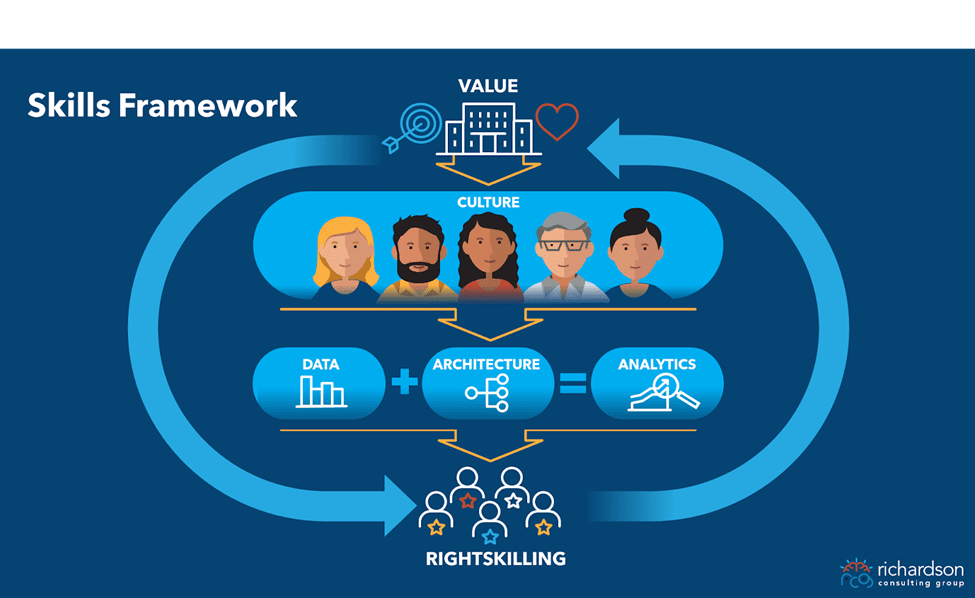
As companies compete for top talent in the global marketplace, a strong skills culture remains a vital component of any successful skills strategy. Top talent is attracted to companies with the right values and culture that support career development, mobility, and success.
A key aspect of this culture is a supportive, skills-focused learning environment. This can include providing access to relevant learning resources, establishing mentoring programs, and fostering a culture of collaboration and continuous learning.
With most companies embracing more remote, virtual, and hybrid work models, the focus has shifted to creating effective virtual or hybrid teams and nurturing a supportive virtual work culture.
This theme resonated in our recent roundtable session as we discussed skills strategy and culture. Our roundtable sessions are a meeting of HR, talent, and learning executives and experts from various industries. We share ideas, challenges and best practices on a wide range of industry and company-specific issues.
In each session, we review the skills strategic framework that serves as the basis of all our discussions, and anchor the group in the most important concepts for building a successful skills strategy.
Skills Strategic Framework
We developed this framework to make sense of skills, what the major components of the strategy are, and where and how to focus.

Skills is a deep, complex topic with interdependent components. Here are some basic tenets of this framework:
- Value – The tangible, measurable value driven by skills. This may include business value (business performance, business agility, customer satisfaction) and/or people value (productivity, career satisfaction, employee engagement).
- Culture – The beliefs that inform the values and mindset that shape behaviors that enable or inhibit skill development. Key categories of behavior include visibility, accountability, and integration.
- Data – The quality, accuracy, reliability and volume of skill data. Data may come from structured (assessments, ratings) or unstructured (email, chat, published content) sources, or may be inferred from education, experience, roles, projects or other data.
- Architecture – The clarity and consistency of skill descriptions, ratings, expectations, and relationship to roles, jobs, career paths, as well as skill development opportunities (learning, coaching, mentoring, stretch assignments, mobility, etc.)
- Analytics – Accuracy and actionability of skill supply, demand and forecast information.
- Rightskilling – Getting the right skills to the right place at the right time. Strategies include hiring for skills, internal mobility, learning opportunities, use of external talent, and partial or full automation.
The value orientation gives purpose to the rightskilling activities. As issues and opportunities arise, skill priorities change for the organization. The areas of focus for culture, data, architecture and analytics may need to flex as well.
Virtual Team Collaboration and Work Culture
The question came from Brett, a Senior Learning Designer at Advocate Health. He identified business cost/expenses, talent search, virtual team collaboration and work culture as the three major challenges that his organization faces.
“There is an uptrend in virtual work teams which presents challenges such as effective collaboration and onboarding of new team members.”
In response to these challenges, Greg, Director of Learning Technology at Edward Jones, shared that his organization is facing the challenge of consolidating its learning function. The process has led to identifying different skill levels and expectations needed to deliver value as a distributed learning team.
A strategy that has resulted from the process is the formation of communities of practice. The communities are elective opt-ins with a focus on key capabilities and upskilling.
“We see learning as an investment, not an expense. So, we purposely allocate weekly time for development and these communities of practice fit nicely into that allocation.”
The practice aids in working together to evolve best practices. It’s like a guild with a focus on upskilling rather than just a meeting of minds. It has helped in creating a consolidated learning function by focusing on key capabilities needed to deliver value as a learning team.
“This approach helps to solve the problem of governance through collaboration and culture,” Greg said.
In my personal experience, communities of practice are an underutilized tool for skill building. They can be organized in different ways from the overall organization structure, and two ways to organize them to enhance skill development are around roles or capabilities.
This can lead people in different parts of an organization or geographies who do the same kinds of work to learn from each other to evolve best practices across the organization. Aside from skill-building, it is a good way to build culture and connection.
In addition to creating communities of practice, Greg said his organization has implemented a Learning Experience Platform (LXP) that serves as an enterprise learning destination. The platform contains everything from brand management to supervisory procedures and is a valuable resource for building a strong culture of learning within the organization.
Community of Practice: Schedule and Governance Structure
Brett asked Greg a follow-up question on the communities of practice. He wanted to know if they meet periodically as a group and how they determine if the governance is being followed.
On the question of the regularity of meetings, Greg stated that the community he is part of, which has the governance structure, doesn’t do that. But other communities that are focused on key capabilities such as consultation meets regularly on Fridays.
“My own governance community now has about 240 people, and the sheer size makes regular meetings difficult. So, we are trying to do a more online asynchronous collaboration to keep the community together.”
Regarding standard management and content governance, Greg shared that whenever someone puts out unique content, they promote it. By doing this, the small community of super administrators can see and evaluate it.
Also, some members of his group do mini-consultations with other groups that are new to the process of curation and microlearning. This co-creation and collaboration process takes care of gaps that would’ve resulted when creating a consistent learner experience. They’ve also created learning experience archetypes that can be reused to ensure positive first and second experiences with any community of practice.
I asked Greg about the timing of the weekly learning allocation. How much time do people dedicate to it and do they do it on the same day or just at their discretion?
Greg responded that the typical allocation varies in different areas of the firm, but it’s often seen as around 10% for development time. This fits into a half-day schedule of the 40-hour week. But the schedule is flexible and not rigid.
Some departments even go longer in their allocations due to the seasonality of the business. There can also be adjustments when a section of the firm needs more time on upskilling due to the introduction of new systems or changing the expectations of clients.
Greg concluded that culture comes with building a value proposition for learning which runs through leadership, as they are the ones who set priorities for their teams.
At Edward Jones, they crafted the value proposition around making it easier for leaders to upskill their people, which helps them fulfill their responsibility to inspire personal growth in their teams. The structures are designed to be marketable to leaders to solve skills problems in their teams easily.
These were some of the key insights on virtual team collaboration, social learning and skills culture from our roundtable. Do you think the community of practice fits your current organization’s learning efforts? Is it a practice you are using or are open to implementing? Are there other learning and collaboration strategies you are using to enable virtual teams and build skills culture? Let me know in the comment section.
If you are experiencing challenges with skills strategy and culture, join one of our upcoming roundtable sessions to share ideas and challenges with HR, talent and learning leaders and industry experts. You can also book a 1:1 session with me if you prefer a more tailored approach.
